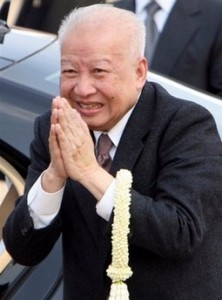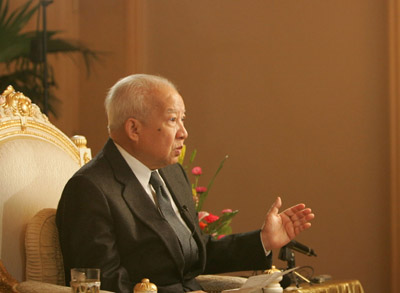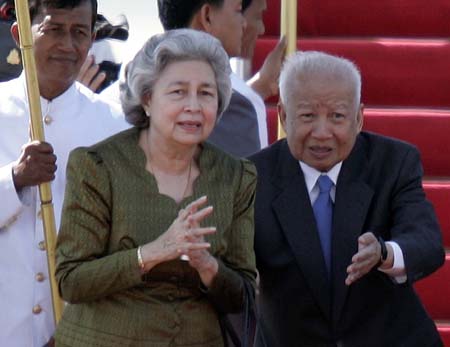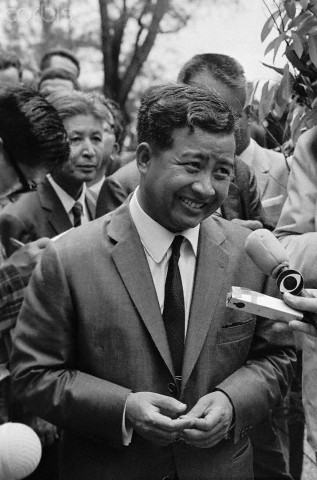<Back to Index>
- Explorer Christopher Columbus, 1451
- Painter Meindert Hobbema, 1638
- King of Cambodia Norodom Sihanouk, 1922
PAGE SPONSOR
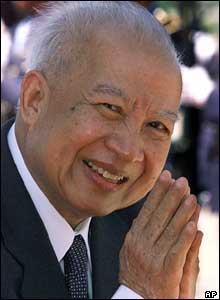
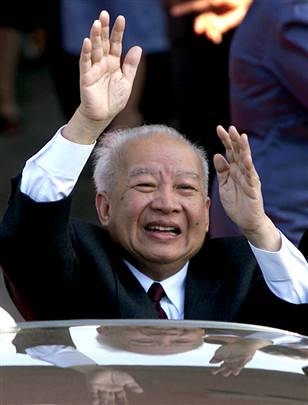
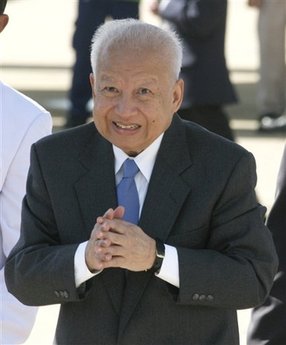
Norodom Sihanouk  regular script
regular script  (October 31, 1922 - October 15, 2012) was the King of Cambodia from
1941 to 1955 and again from 1993 until his semi - retirement and
voluntary abdication on 7 October 2004 in favor of his son, the current (as of 2012) King Norodom Sihamoni. Since his abdication, he was known as The King - Father of Cambodia (Khmer: Preahmâhaviraksat), a position in which he retained many of his former responsibilities as constitutional monarch.
(October 31, 1922 - October 15, 2012) was the King of Cambodia from
1941 to 1955 and again from 1993 until his semi - retirement and
voluntary abdication on 7 October 2004 in favor of his son, the current (as of 2012) King Norodom Sihamoni. Since his abdication, he was known as The King - Father of Cambodia (Khmer: Preahmâhaviraksat), a position in which he retained many of his former responsibilities as constitutional monarch.
The son of King Norodom Suramarit and Queen Sisowath Kossamak, Sihanouk held so many positions since 1941 that the Guinness Book of World Records identifies him as the politician who has served the world's greatest variety of political offices. These included two terms as King, two as Sovereign Prince, one as president, two as prime minister, and one as Cambodia's non - titled head of state, as well as numerous positions as leader of various governments - in - exile.
Most
of these positions were only honorific, including the last position as
constitutional King of Cambodia. Sihanouk's actual period of effective
rule over Cambodia was from 9 November 1953, when France granted independence to Cambodia, until 18 March 1970, when Lon Nol and the National Assembly deposed Sihanouk.
Since his abdication, Sihanouk's official Cambodian title was:
Preah Karuna Preah Bat Sâmdech Preah Norodom Sihanouk Preahmâhaviraksat
In Khmer:
ព្រះករុណាព្រះបាទសម្តេចព្រះ នរោត្តម សីហនុ ព្រះមហាវីរក្សត្រ
The literal translation of the title :
- Preah ("Sacred,")
- Karuna ("Compassionate," referring to the Buddhist concept Karuna)
- Bat ("Foot", from Sanskrit Pāda, cognate to Latin Pes, pedis, French pied, English foot)
- Sâmdech ("Lord, Prince, Excellency")
- Preah ("Sacred")
- Norodom (given name of Norodom of Cambodia, used as a family name by his descendants. from Narottam in Sanskrit meaning best in quality (Uttam) among men (Nar).
- Sihanouk (given name of Sihanouk; it is a contraction of Siha-, "Lion," from Sanskrit Siṃha, cognate of Singa- in Singapore; and -Hanouk, from Sanskrit Hanu, "Jaws")
- Preahmâhaviraksat (Preah, "Sacred"; -Mâha-, Sanskrit "Great," Maha- in Maharaja; -Vira-, Sanskrit vīra "brave or eminent man; hero; chief," this Sanskrit word is cognate to many words e.g. Latin Vir, English virile and Greek hero; -Ksat, "Warrior, Ruler," cognate of the Indian word Kshatriya).
The word "father" does not appear in the Cambodian title, but in Western languages his title is translated as "His Majesty King - Father Norodom Sihanouk," to distinguish from the title of his son the new King, which is "His Majesty King Norodom Sihamoni."
Despite
the great ritualism surrounding the Cambodian monarchy, Sihanouk
always maintained close relations with the Cambodian people, and when
addressing him, or talking about him, they most often called him  , Sâmdech Euv, which literally means "Prince Dad," "My Lord Dad" (French: Monseigneur Papa).
, Sâmdech Euv, which literally means "Prince Dad," "My Lord Dad" (French: Monseigneur Papa).
After World War II and into the early 1950s, King Sihanouk's aspirations became much more nationalistic and he began demanding independence from the French colonists and their complete departure from Indochina. This echoed the sentiments of the other fledgling nations of French Indochina: the State of Vietnam, the Democratic Republic of Vietnam, and the Kingdom of Laos. He went into exile in Thailand in May 1953 because of threats on his life by the French and only returned when independence was granted on 9 November 1953. Whilst independent, Cambodia retained an alliance with the French Union, until the end of the First Indochina War and the subsequent official end of French Indochina. On 2 March 1955, Sihanouk abdicated in favor of his father, established the Sangkum and took the post of Prime Minister a few months later, after having obtained an overwhelming victory in the parliamentary elections on September 1955.
On August 31, 1959, Ngo Dinh Nhu, the younger brother and chief adviser of South Vietnamese president Ngo Dinh Diem, failed in an attempt to assassinate Sihanouk. He ordered his agents to send parcel bombs to the Cambodian leader. Two suitcases were delivered to the Sihanouk's palace, one addressed to the head of state, and the other to Prince Vakrivan, his head of protocol. The deliveries were labelled as originating from an American engineer who had previously worked in Cambodia and purported to contain gifts from Hong Kong. Sihanouk's package contained a bomb, but the other did not; however, Vakrivan opened both on behalf of the monarch and was killed instantly, as was a servant. The explosion happened adjacent to a room in the palace where Sihanouk's parents were present.
Following his father's death in 1960, Sihanouk won general election as head of state, but received the title of Prince rather than King. In 1963, he made a change in the constitution that made him head of state for life. While he was not officially King, he had created a constitutional office for himself that was exactly equal to that of the former Kingship.
When the Vietnam War raged, Sihanouk promoted policies that he claimed to preserve Cambodia's neutrality and most importantly security. While he in many cases sided with his neighbors, pressures upon his government from all sides in the conflict were immense, and his overriding concern was to prevent Cambodia from being drawn into a wider regional war. In so doing he made difficult choices of alliances in pursuit of the least dangerous course of action, within a political environment where genuine neutrality was likely impossible at the time. In the spring of 1965, he made a pact with the People's Republic of China and North Vietnam to allow the presence of permanent North Vietnamese bases in eastern Cambodia and to allow military supplies from China to reach Vietnam by Cambodian ports. Cambodia and Cambodian individuals were compensated by Chinese purchases of the Cambodian rice crop by China at inflated prices. He also at this time made many speeches calling the triumph of Communism in Southeast Asia inevitable and suggesting Maoist ideas were worthy of emulation. In 1966 and 1967, Sihanouk unleashed a wave of political repression that drove many on the left out of mainstream politics. His policy of friendship with China collapsed due to the extreme attitudes in China at the peak of the Cultural Revolution. The combination of political repression and problems with China made his balancing act impossible to sustain. He had alienated the left, allowed the North Vietnamese to establish bases within Cambodia and staked everything on China's good will. On 11 March 1967, a revolt in Battambang Province led to the Cambodian Civil War.
On March 18, 1970, while Sihanouk was out of the country travelling, Prime Minister Lon Nol convened the National Assembly which voted to depose Sihanouk as head of state and gave Lon Nol Emergency powers. Prince Sisowath Sirik Matak, Sihanouk's cousin who had been passed over by the French government in 1941, retained his post as Deputy Prime Minister. The new Khmer Republic was immediately recognized by the United States.
After he was deposed, Sihanouk fled to Beijing, formed the National United Front of Kampuchea (Front Uni National du Kampuchéa - FUNK) and began to support the Khmer Rouge in their struggle to overthrow the Lon Nol government in Phnom Penh. He initiated the Gouvernement Royal d'Union Nationale du Kampuchéa (Royal
Government of the National Union of Kampuchea), which included Khmer
Rouge leaders. After Sihanouk showed his support for the Khmer Rouge by
visiting them in the field, their ranks swelled from 6,000 to 50,000
fighters. Many of the new recruits for the Khmer Rouge were apolitical
peasants who fought in support of the King, not for communism, of which
they had little understanding. King Sihanouk would later argue (1979)
that the monarchy being abolished, he was only fighting for his
country's independence, "even if [his] country had to be Communist." During Lon Nol's regime, Sihanouk mostly lived in exile in North Korea, where a 60 room palatial residence
which even had an indoor movie theater, was built for him. He would
later return to his Pyongyang palace after the 1979 Vietnamese invasion.
When the Khmer Republic fell to the Khmer Rouge in April 1975, Prince Sihanouk became the symbolic head of state of the new régime while Pol Pot remained in power. Sihanouk, who had imagined living like a retired country gentleman and perhaps being 'a public relations man for [his] country and have [...] jazz parties and do some filming' was to spend the next few years virtually as a hostage of the Khmer Rouge. The next year, on April 4, 1976, the Khmer Rouge forced Sihanouk out of office again and into political retirement. During the Vietnamese invasion, he was sent to New York to speak against Vietnam before The United Nations. After his speech, he sought refuge in China and in North Korea.
The Vietnamese invasion of Cambodia in December 1978 ousted the Khmer Rouge. While welcoming the ousting of the Khmer Rouge government, he remained firmly opposed to the Vietnamese installed Heng Samrin government of People's Republic of Kampuchea. Hence, Sihanouk demanded Cambodia's seat in the UN be left vacant, since neither the Pol Pot regime nor Heng Samrin represented the Khmer people. Although claiming to be wary of the Khmer Rouge and demanding that the Khmer Rouge representatives that still held Cambodia's UN seat be expelled, Sihanouk again joined forces with them in order to provide a united front against the Vietnamese occupation. It has been argued that one of the reasons was the US pressure to work with the Khmer Rouge. In 1982, he moved completely into opposition of the Vietnam supported government, becoming President of the Coalition Government of Democratic Kampuchea (CGDK), which consisted of his own Armée Nationale Sihanoukiste (ANS), Son Sann's Khmer People's National Liberation Front (KPNLF), and the Khmer Rouge. The Vietnamese withdrew in 1989, leaving behind a pro - Vietnamese government under ex-Khmer Rouge cadre Hun Sen to run the People's Republic of Kampuchea (PRK).
In the late 1980s and early 1990s, Sihanouk's opposition forces drew limited military and financial support from the United States, which sought to assist his movement as part of the Reagan Doctrine effort to counter Soviet and Vietnamese involvement in Cambodia. One of the Reagan Doctrine's principal architects, the Heritage Foundation's Michael Johns, visited with Sihanouk's forces in Cambodia in 1987, and returned to Washington urging
expanded U.S. support for the KPLNF and Sihanouk's resistance forces as
a third alternative to both the Vietnamese installed and supported
Cambodian government and the Khmer Rouge, which also was resisting the
government.
Peace
negotiations between the CGDK and the PRK commenced shortly thereafter
and continued until 1991 when all sides agreed to a comprehensive
settlement which they signed in Paris. Prince Sihanouk returned once
more to Cambodia on 14 November 1991 after thirteen years in exile.
In 1993, Sihanouk once again became King of Cambodia. During the restoration, however, he suffered from ill health and traveled repeatedly to Beijing for medical treatment.
Sihanouk's leisure interests included music (he has composed songs in Khmer, French, and English) and film. He became a prodigious filmmaker over
the years, directing many movies and orchestrating musical
compositions. He became one of the first heads of state in the region to
have a personal website, which has proven a cult hit. It draws more
than a thousand visitors a day, which constitutes a substantial portion
of his nation's Internet users. Royal statements were posted there daily.
Sihanouk went into self imposed exile in January 2004, taking up residence in Pyongyang, North Korea, and later in Beijing, People's Republic of China. Citing reasons of ill health, he announced his abdication of The Throne on October 7, 2004. Sihanouk was diagnosed with B-Cell Lymphoma in his prostate in 1993; the disease recurred in his stomach in 2005, and a new cancer was found in December 2008. Sihanouk also suffered from diabetes and hypertension.
The constitution of Cambodia has no provision for an abdication. Chea Sim, the President of the Senate, assumed the title of acting Head of State (a title he has held many times before), until the Throne Council met on October 14 and appointed H.R.H. Prince Norodom Sihamoni, one of Sihanouk's sons, as the new King.
Sihanouk had been receiving medical treatment in Beijing since January, 2012 for a number of health problems, including colon cancer, diabetes, and hypertension. He died of a heart attack in Beijing, on 15 October 2012, 16 days before what would have been his 90th birthday. State flags flew at half-mast, and King Norodom Sihamoni and Prime Minister Hun Sen went to Beijing to bring home Sihanouk's body for a funeral at the Royal Palace.
Prince Sisowath Thomico,
Sihanouk's assistant and nephew, said "his death was a great loss to
Cambodia," adding that Sihanouk had dedicated his life "for the sake of
his entire nation, country and for the Cambodian people." United Nations Secretary - General Ban Ki-moon
also commented, acknowledging Sihanouk's "long dedication to his
country and his legacy as a unifying national leader who is revered by
Cambodians and respected internationally." After Sihanouk's death, the National Television of Kampuchea repeatedly screened a 30 minute documentary about his life.
100,000 Cambodians were expected to line the route from the airport to
the Royal Palace for the return of Sihanouk's body, but state television
broadcaster TVK later said about 1,200,000 people had turned out. On November 28, 2012, King Father Norodom Sihanouk was anointed by Royal Decree of HM King Norodom Sihamoni with the title Preah Karuna Preah Norodom Sihanouk Preah Borom Ratanakkot (Khmer: ព្រះករុណាព្រះនរោត្តម សីហនុ ព្រះបរមរតនកោដ្ឋ) (literally meaning The King who lies in the Diamond Urn).
On 1 February 2013, crowds gathered on the streets of Phnom Penh to
bid one last farewell to Sihanouk, as his body was carried through the
city. Other foreign dignities also attended his cremation ceremony,
including French Prime Minister Jean-Marc Ayrault, Prince Akishino of Japan, China's Jia Qinglin, Prime Minister Nguyen Tan Dung of Vietnam, Prime Minister Yingluck Shinawatra of Thailand, as well as US ambassador to Cambodia William E. Todd, and many more.
The body was brought to the Royal Palace, where it was cremated on 5
February 2013. Sihanouk's ashes were then submersed into the Mekong
River.
After
his death, Prime Minister Hun Sen
announced that a statue of Sihanouk would be made. It was inaugurated
on 11 October 2013 with King Norodom Sihamoni and Queen - Mother Norodom
Monineath present at the ceremony. The statue is located in Phnom Penh,
near the Independence Monument. The government also announced that
October 15 will become an official public holiday as a mourning period
of Norodom Sihanouk.
Sihanouk reportedly has had several wives and concubines, producing at least fourteen children in a period of eleven years. According to Time (June 30, 1956), however, his only legal wives have been Princess Samdech Norleak (married 1955) and Paule Monique Izzi (married 1955), who is a step - granddaughter of HRH Prince Norodom Duongchak of Cambodia and the younger daughter of Pomme Peang and her second husband, Jean - François Izzi, a banker. A profile of Sihanouk in The New York Times (June 4, 1993) stated that the King met Monique Izzi in 1951, when he awarded her a prize in a beauty pageant.
According to Royal Ark's genealogy of the Cambodian Royal Family, however, Sihanouk has been married seven times.
